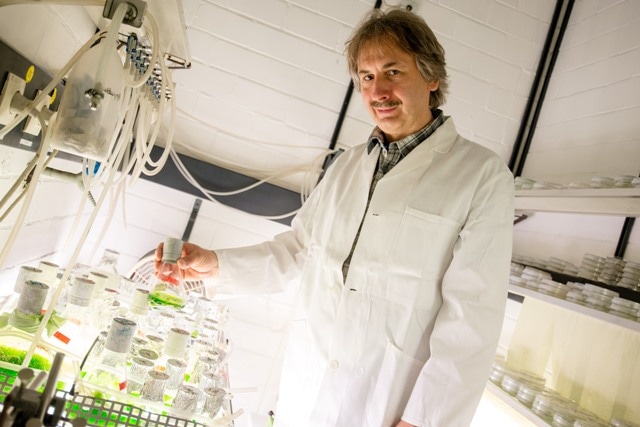May 31 2016
A potential energy carrier for the future is hydrogen, but despite this fact its large scale production continues to be a major problem. Recently, Bochum-based scientists have discovered a novel approach for a method suitable for industrial applications.
 Green algae possess an enzyme for producing hydrogen, called hydrogenase. Together with his colleagues, Thomas Happe engineers such enzymes in the test tube. (© RUB, Marquard)
Green algae possess an enzyme for producing hydrogen, called hydrogenase. Together with his colleagues, Thomas Happe engineers such enzymes in the test tube. (© RUB, Marquard)
The Bochum research team has engineered a new enzyme in the test tube that produces hydrogen and is as efficient as the original. The enzyme is a hydrogenase produced by green algae and contains a cofactor and protein scaffold. Cofactor is the center of reaction where the components dock and react together. The cofactor assembled spontaneously when different chemically synthesized substances were added to the protein scaffold.
Dr Jens Noth and Prof Dr Thomas Happe at the Ruhr-Universität Bochum along with their team published their findings in “Angewandte Chemie” journal. The scientists plan to lay the basis that would initiate the production of synthetic hydrogen-producing enzymes at an industrial scale in the future.
Hydrogenases do not require the use of platinum, which is a costly metal and is presently required for the synthesis of hydrogen. Hydrogenases are extremely efficient energy carrier producers.
Substituting sulfur with selenium
Hydrogenase cofactor consists of sulfur and iron atoms. They are bonded within the protein in a unique fashion. In the artificial hydrogenase variant, the scientists substituted the sulfur atoms with selenium atoms, which have double their mass. The scientists marked the cofactor of the enzyme using this method and were able to comprehend it in a more detailed way.
The analysis proved that the artificial variant and the original natural enzyme had the same biochemical properties. Using other biophysical techniques, the researchers want to discover the mechanism involved in the reaction used by hydrogenase for producing hydrogen.
Cooperation partner at the Ruhr-Universität
The research team Photobiotechnology led by Thomas Happe collaborated with the group of Dr Ulf-Peter Apfel at the Chair of Inorganic Chemistry and the biophysical groups of Prof Dr Klaus Gerwert and Prof Dr Eckhard Hofmann for the study.
Funding
The project was funded by German Research Foundation in the course of the German-Israeli project cooperation “Nanoengineered optoelectronics with biomaterials and bioinspired assemblies” and also under the umbrella of the Cluster of Excellence Resolv (EXC1069) and an Emmy Noether Grant (AP242/2-1). Volkswagen Foundation (LigH2t) and “Verband der Chemischen Industrie” (Liebig Grant) supplied additional funding.